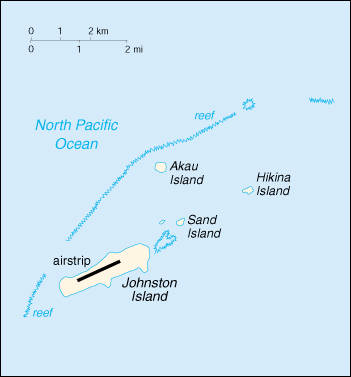|
Location:
Oceania, atoll in strategic location in the North Pacific Ocean,
about one-third of the way from Hawaii to the Marshall Islands.
Johnston Island and Sand Island are natural islands, which have
been expanded by coral dredging; North Island (Akau) and East
Island (Hikina) are manmade islands formed from coral dredging;
closed to the public.
Both
the US and the Kingdom of Hawaii annexed Johnston Atoll in 1858,
but it was the US that mined the guano deposits until the late
1880s. The US Navy took over the atoll in 1934, and subsequently
the US Air Force assumed control in 1948. The site was used
for high altitude nuclear tests in the 1950s and 1960s, and
until late in 2000 the atoll was maintained as a storage and
disposal site for chemical weapons (Johnston Atoll Chemical
Agent Disposal System (JACADS)). Munitions destruction is now
complete. Cleanup and closure of the facility is progressing,
with completion anticipated in 2004.
Government: Unincorporated territory of the US; administered
from Washington, DC, by the US Defense Threat Reduction Agency
(DTRA) and managed cooperatively by DTRA and the Fish and Wildlife
Service of the US Department of the Interior as part of the
National Wildlife Refuge system. Economic activity is limited
to providing services to US military personnel and contractors
located on the island. All food and manufactured goods must
be imported.
Population: No indigenous inhabitants. In previous years,
there was an average of 1,100 US military and civilian contractor
personnel present; as of September 2001, population decreased
to approximately 970 when US Army Chemical Activity Pacific
(USACAP) departed. As of May 2005, all U.S. government personnel had left the island.
Lage:
Stategisch gelegenes Atoll in Ozeanien im Nordpazifik. Etwa
ein-drittel des Weges von Hawaii zu den Marshall Inseln. Johnston
Island und Sand Island sind natürliche Inseln, die durch
den Aushub von Korallen vergrössert wurden. Die Nordinsel
(Akau) und die Ostinsel (Hakini) sind durch den Aushub von Korallen
geschaffen worden. Die Inseln sind für die Öffentlichkeit
nicht zugänglich.
Sowohl die Vereinigten Staaten als auch das Königreich
Hawaii annektierten 1858 das Atoll, aber die USA bauten das
Guano bis Ende der 1880er Jahre ab. Die US Navy übernahm
das Atoll 1934, und 1948 die US Air Force. Das Gelände
wurde in den 1950er und 1960er Jahren als Testgelände für
US-Nuklearwaffen genutzt. Bis Ende 2000 wurde es als Lager des
Johnston Atoll Chemical Agent Disposal System (JACADS). Die
Vernichtung der Munition ist abgeschlossen. Aufräumarbeiten
und Schliessung der Anlage schreiten fort und werden voraussichtlich
2003 abgeschlossen sein.
Regierung: Nichtinkooperiertes Territorium der Vereinigten Staaten, das von Washington D.C. durch die US Defense Threat Reduction Agency (DTRA) verwaltet wuird, zusammen mit dem Fish and Wildlife Service of the US Department of the Interior als Teil des National Wildlife Refuge system. Wirtschaftliche Tätigkeiten beschränken sich auf Dienstleistungen für US Militärpersonnal und Vertragsarbeiter auf der Insel. Sämmtliche Nahrungsmittel und Gegenstände müssen importiert werden.
Population: Keine einheimische Bevölkerung. In den vergangenen Jahren hielten sich durchschnittlich 1.100 Mitglieder des amerikanischen Militärs und Zivilisten dort auf. Mit Abzug von US Army Chemical Activity Pacific (USACAP) inm September 2001 schrank die Bevölkerung auf etwa 970. Seit May 2005 sind keine Angestellten der US-Regierung mehr auf der Insel.
|


